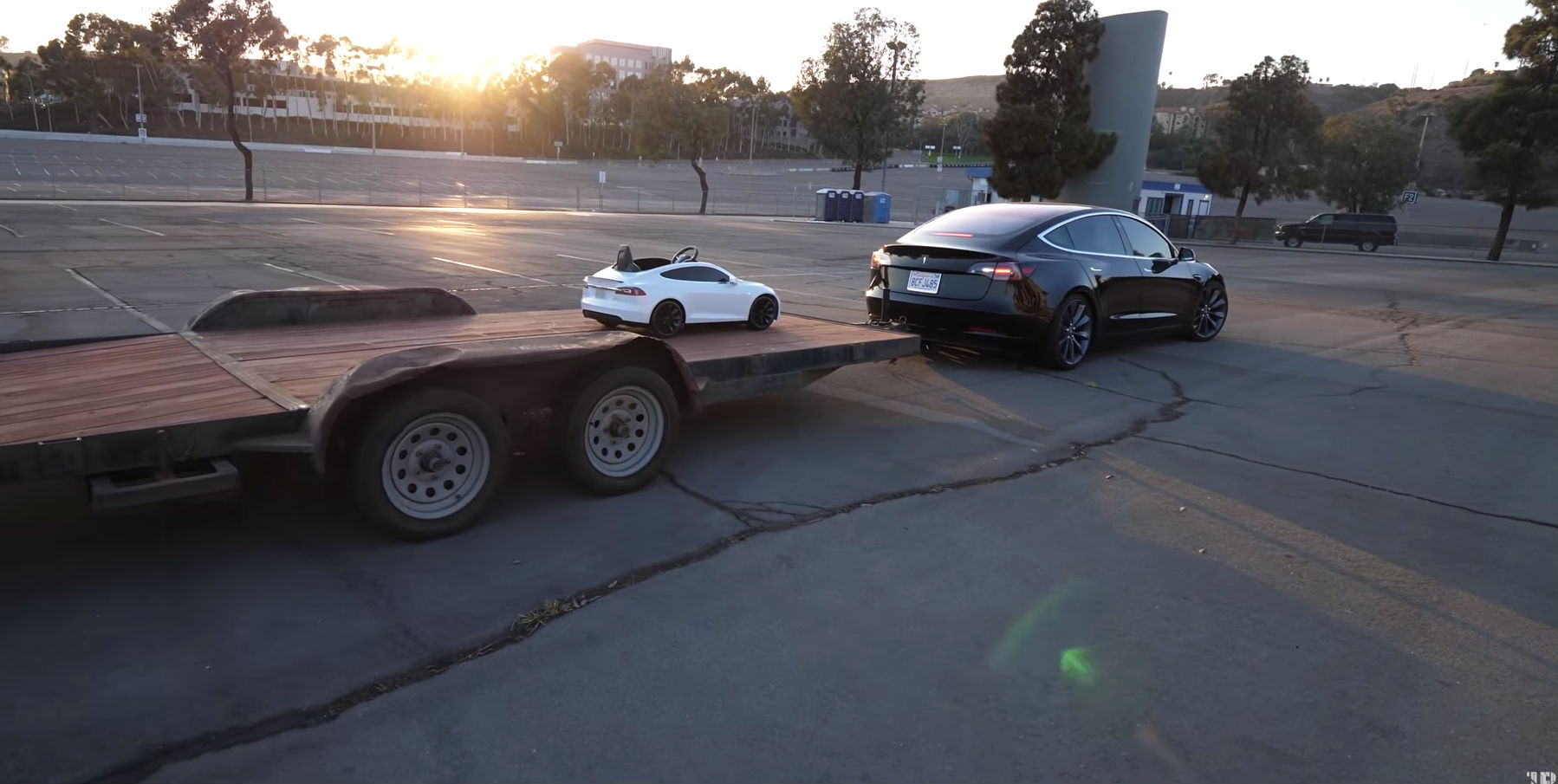
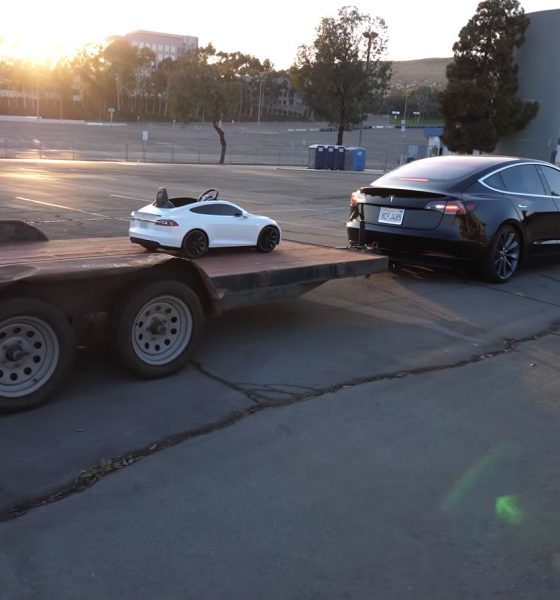
DIY
Tesla Model 3 tow hitch DIY installation turns electric sedan into a utility champ
The Tesla community is home to a number of very creative DIY enthusiasts, many of whom have come up with clever projects to make their vehicles even more attractive and useful than they already are. One of these projects was showcased recently in YouTube, in a collaboration between Teslanomics host Ben Sullins and tech teardown expert JerryRigEverything.
The Model 3 has not been given an official tow rating yet, but the vehicle’s powerful electric motors invoke the idea that the electric sedans are fully capable of hauling some serious cargo. This was the focus of the recent DIY project involving the two YouTube hosts, as they installed a tow hitch on a Long Range RWD Model 3. With a tow hitch installed, the Model 3 would have the capability to tow trailers, carry bikes, and become an all-around more productive electric car.
The pair opted to install the Stealth EcoHitch on the Model 3, since the contraption is practically invisible when it’s not being used. The hitch itself has a towing capacity of 2,000 lbs and a tongue weight of 200 pounds. Installing the hitch was a simple and straightforward process, starting with the removal of the tail lights and the car’s rear bumper. The plastic plate at the bottom of the Model 3 was also removed.
Once the rear bumper was taken off, it was just a matter of removing the Model 3’s crash bar and replacing a couple of metal plates with the tow hitch itself, followed by cutting a hole into the plastic plate at the bottom of the vehicle. With these steps done, the DIY installation of the Model 3 tow hitch was completed.
The two YouTube hosts tested out the vehicle’s towing capabilities by hooking up the electric sedan with a 1,700-lb trailer. A Radio Flyer Model S for Kids and the JerryRigEverything host himself were also on the trailer, which likely (or closely) maxed out the towing capacity of the Stealth EcoHitch installed on the Model 3. After driving around hauling the trailer and its cargo, the Teslanomics host noted that he did not feel any lag in the vehicle’s performance at all.
Tesla’s vehicles are incredibly powerful. Thanks to the instant torque provided by their electric motors, Tesla’s electric cars are capable of pulling some serious weight. Just like the acceleration figures of its vehicles, Tesla is quite conservative with the listed towing capacity of its cars. The Model X, for one, is listed with a towing capacity of 5,000 lbs when equipped with 20″ wheels.
As later feats would indicate, the Model X is actually capable of hauling far more than 5,000 lbs of cargo. Earlier this year, Tesla YouTube host Bjorn Nyland’s Model X successfully pulled a 95,000-lb semitrailer across an icy road. Not long after that, the Boring Company, Elon Musk’s tunneling startup, posted a video of a Tesla Model X pulling 250,000 lbs of dirt (that’s 50 times the rated towing capacity for the SUV) from a tunnel.
The tow hitch installation is just one of several cool DIY projects that have been shared online for the Model 3. Just recently, a Model 3 owner figured out a way to give the electric sedan an automatic frunk through the use of aftermarket gas spring struts. A simple wood staining DIY project earlier this year also gave the Model 3’s ubiquitous wooden dash a unique splash of elegance.
Watch the Tesla Model 3’s DIY tow hitch installation in the video below.

DIY
Tesla Model 3 pickup “Truckla” gets updates and a perfectly wholesome robot charger
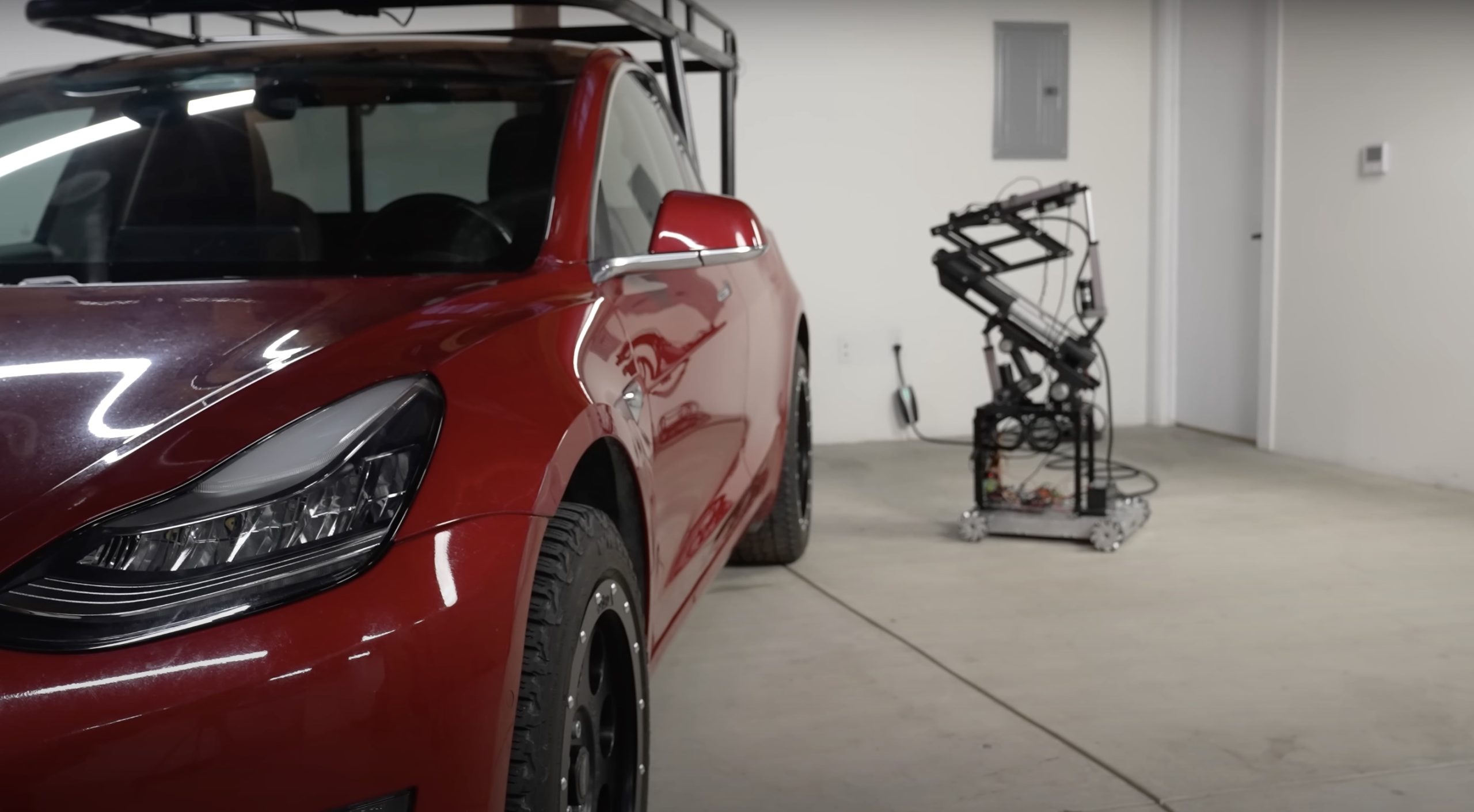
Back in 2019, YouTuber Simone Giertz, the self-proclaimed “Queen of Sh*tty Robots,” created a one-off Tesla Model 3 build that took the automotive world by storm. Fondly dubbed as “Truckla,” Giertz noted that the vehicle was actually her dream car — as crazy as that may sound.
Now almost four years later, the YouTuber posted an update on Truckla. And just like every other big project that one probably started, Giertz stated that she actually stopped working on Truckla when the vehicle was about 80% complete. The car is driving though, but a lot of stuff was not really working very well.
Thus, for her Truckla update, Giertz shared how most of her Model 3 pickup truck conversion was essentially completed. Truckla got a lot of detailing done, she got a slight lift, and she now has a functional tailgate. One has to admit, Truckla’s tailgate is pretty darn cool.
The “Queen of Sh*tty Robots” also opted to give Truckla a friend in the form of an automatic robot charger. Unlike Tesla’s rather interesting snake charger from years past, Truckla’s charger would come in the form of a rover, thanks to her friends at robotics platform Viam. Giertz aptly named Truckla’s robot charger friend “Chargela,” which is an appropriate name for such an invention.
Also true to form for Giertz, Chargela’s first encounter with Truckla was just a tiny bit awkward. One could say that Chargela may have just been a little bit nervous on his first try without human hands helping him. Most importantly, the system did work, so Giertz would likely keep using Chargela for her Model 3 pickup.
Teslas are very tech-heavy vehicles, so projects like Giertz’s Truckla are always remarkable. The fact that the Model 3 works perfectly fine despite having a good chunk of it cut off and turned into a pickup truck bed is mighty impressive any way one looks at it. Overall, Truckla will always be one of the coolest Tesla DIY projects to date, so any updates about the vehicle are always appreciated.
Truckla’s nearly four-year update can be viewed below.
Don’t hesitate to contact us with news tips. Just send a message to simon@teslarati.com to give us a heads up.
DIY
Tesla fan creating ‘CyberRoadster’ using Model 3 Performance parts in epic DIY build
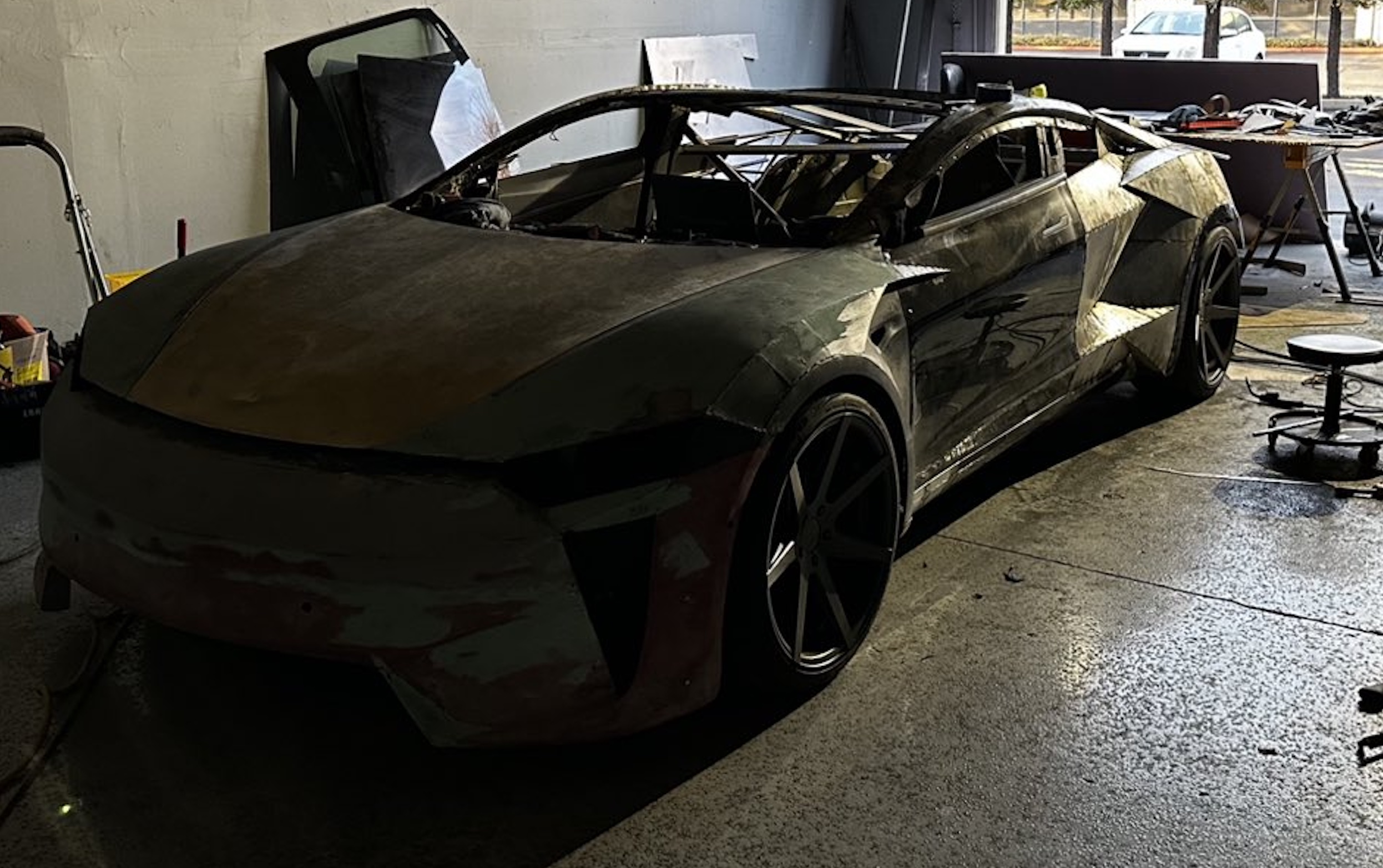
A Tesla owner is taking his hobby and love for electric vehicles to new levels by creating what could only be described as one of the coolest EV-related DIY projects to date. The idea for the project is simple: what happens when you cross a supercar with the Cybertruck? You end up with a two-seater CyberRoadster.
Tesla owner David Andreyev, who goes by the username @Cyber_Hooligan_ on Twitter, has spent the last few months creating a Cybertruck-inspired version of the next-generation Roadster made from a salvaged Model 3 Performance. Starting with a Model 3 Performance is an inspired choice, considering that it is Tesla’s first vehicle that has a dedicated Track Mode.
A look at Andreyev’s YouTube channel, which can be accessed here, shows the meticulous build that the Tesla owner has implemented on the project car. What’s particularly cool about the CyberRoadster is the fact that it’s being built with parts that are also from other Tesla vehicles, like its front bumper that came from a new Model S. Recent videos suggest that the project car’s rear bumper will be from a new Model S as well.
The journey is long for Andreyev, so the completion of the CyberRoadster will likely take some more time. Despite this, seeing the Tesla owner’s DIY journey on such an epic build is more than satisfying. And considering that the CyberRoadster is evidently a labor of love from the Tesla owner, the final results would likely be extremely worth it.
There’s a lot of crazy Tesla modifications that have been done as of late. But some, as it is with a lot of things on the internet these days, have become more silly gimmicks than serious automotive projects. Fortunately, car enthusiasts like Andreyev, who just happen to also love electric vehicles, are taking it upon themselves to create one-of-a-kind EVs that would surely capture the attention of anyone on the road.
Check out the latest video in the CyberRoadster’s creation below.
Don’t hesitate to contact us with news tips. Just send a message to simon@teslarati.com to give us a heads up.
DIY
Tesla owner ‘charges’ Model 3 with homemade solar panel trailer
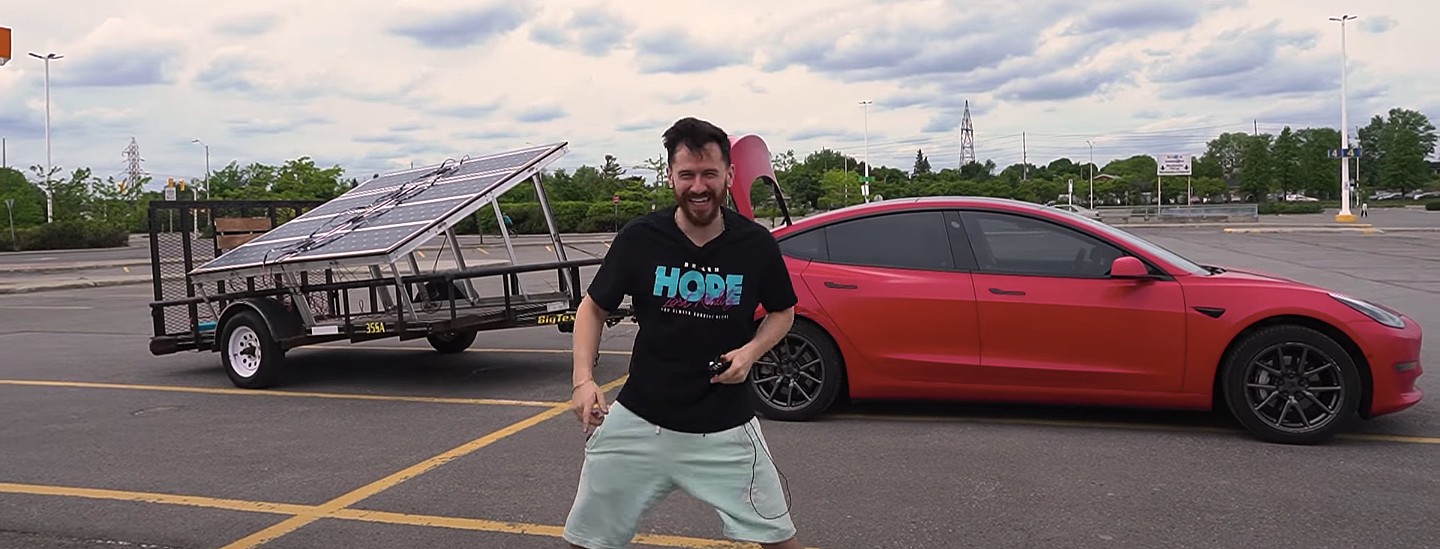
A Tesla owner has demonstrated a rather novel way to charge his Model 3. In a recent video, Sean Callaghan of the ItsYeBoi YouTube channel opted to use a series of off-the-shelf solar panel sheets onto a towable trailer to create a mobile charging unit for his all-electric sedan.
Callaghan planned to use only the sun and the solar sheets purchased from e-commerce platform Wish to charge his Model 3. The solar panel sheets would collect energy from the sun and transfer it to a control panel. The control panels were connected to batteries that would hold the energy—the batteries connected to an inverter, which would then charge the Tesla Model 3.
The entire assembly would provide the Model 3 with about 800 watts of energy on a completely sunny day. However, Callaghan shot the video when weather was overcast, so the entire solar panel trailer build only managed to provide around 300 watts throughout the YouTube host’s test.
To put this into perspective, a 100 volt home wall outlet provides 1.4 kilowatts of power, or 1,400 watts. Therefore, the 300-watt solar panel assembly built by Callaghan was producing less than 25% of the energy of a typical wall outlet. This is pretty marginal compared to Tesla’s 250-kilowatt V3 Superchargers, which provides 250,000 watts, or about 833 times as much power as the makeshift solar panel build.
However, Callaghan’s goal was not to charge the vehicle quickly. He explained the idea came from a previous video where he used a $5,000 Wish-purchased wind turbine to charge his Model 3. He wanted to test the effectiveness and efficiency of the system, which was questionable due to the time it would take to charge the battery fully.
The Model 3 battery pack is 78 kWh, and with Callaghan’s 300-watt system charging his electric vehicle, it would take 260 hours to supply the Tesla’s battery to full capacity.
In the past, electric vehicle enthusiasts have asked Tesla CEO Elon Musk why the company’s vehicles do not contain solar glass roofing, which would charge the car while the owner is driving. Musk has explained that the efficiency of this idea is challenging and likely would not provide an ample amount of range.
When asked about the idea of putting solar panels on the top of Tesla’s vehicles in 2017, Musk responded that the idea was “Not that helpful, because the actual surface of the car is not that much, and cars are often inside. The least efficient place to put solar is on the car.” It also would not be cost-effective for Tesla because “the cost of the panels and electronics, R&D and assembly would never pay for itself in the life of the vehicle, compared to charging from the wall in your garage,” Quartz noted.
That being said, Tesla plans to implement solar panels onto the motorized tonneau of the upcoming Cybertruck. The idea was discussed on Twitter when Musk stated that the optional feature would add “15 miles per day, possibly more” when parked in the sunlight. Also, fold-out solar wings could help capture enough solar energy for 30 to 40 miles a day.
Watch Sean Callaghan’s video of his makeshift solar panel trailer below.








